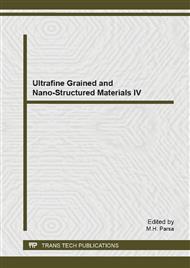p.659
p.665
p.670
p.675
p.683
p.688
p.693
p.698
p.703
Characterization of Nano-Structured Multiferroic Bismuth Ferrite Produced via Solid State Reaction Route
Abstract:
Multiferroic bismuth ferrite, BiFeO3, was synthesized via conventional solid-state reaction method using Bi2O3, Fe2O3 as starting materials. Effects of Bi2O3/Fe2O3 molar ratio and calcination temperature on the phase composition, morphology and magnetic properties of produced powders were systematically studied using XRD, FESEM/EDS and VSM techniques, respectively. The results revealed that BiFeO3 phase with rhombohedral R3c structure with a mean particle size of 40 nm was formed in the sample processed with a Bi2O3/Fe2O3 molar ratio of 1:1 after calcination at 800 °C. Rietveld analysis which was applied to the x-ray diffraction data via MAUD software indicated high purity of 95%wt for the above sample. Deviation from the stoichiometric molar ratio (Bi2O3/Fe2O3: 0.9, 1.1, 1.2) yielded higher content of the intermediate phases of Bi2Fe4O9 and Bi25FeO40. FESEM studies showed that the mean particle size was increased from 40 to 62 nm by increasing calcination temperature from 800 to 850 °C. VSM results for 1:1 molar ratio samples indicated that increasing the calcination temperature from 800 to 850 °C increased saturation magnetization (Ms) from 0.087 to 0.116 emu/g and also coercive field (Hc) from 60 to 100 Oe.
Info:
Periodical:
Pages:
683-687
Citation:
Online since:
November 2013
Authors:
Keywords:
Price:
Сopyright:
© 2014 Trans Tech Publications Ltd. All Rights Reserved
Share:
Citation:


